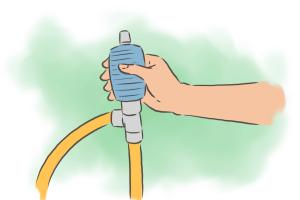Ultimate Guide to Emptying a Waterbed: Step-by-Step Instructions

-
Quick Links:
- Introduction
- Understanding Waterbeds
- Tools Needed
- Step-by-Step Guide to Emptying a Waterbed
- Post-Emptying Tips
- Common Mistakes to Avoid
- Case Studies
- Expert Insights
- FAQs
Introduction
Waterbeds offer a unique sleeping experience, but they come with their own set of maintenance challenges. Whether you're relocating, cleaning, or replacing your waterbed, knowing how to empty it correctly is crucial. This comprehensive guide will walk you through the entire process, ensuring a smooth and hassle-free experience.Understanding Waterbeds
Waterbeds are filled with water, providing support and comfort. They come in two main types: hard-sided and soft-sided. Understanding how your specific waterbed functions will help you empty it without damaging the structure.Types of Waterbeds
- **Hard-Sided Waterbeds**: These are typically framed and have a more rigid structure. - **Soft-Sided Waterbeds**: These have a softer outer layer and are usually more flexible.Benefits of Waterbeds
- Pressure relief for joints - Temperature control capabilities - Customizable firmnessTools Needed
Before you start the emptying process, gather the following tools: - Waterbed drain pump or siphon - Hose (if using a siphon) - Buckets (for manual draining) - Towels or absorbent cloths - Waterbed patch kit (in case of leaks)Step-by-Step Guide to Emptying a Waterbed
Emptying a waterbed can seem daunting, but with the right approach, it can be straightforward. Follow these steps:Step 1: Prepare the Area
Clear the area around the waterbed to ensure you have enough space to work. Remove any bedding, pillows, or accessories from the waterbed.Step 2: Locate the Drain Valve
Find the drain valve, usually located at the foot of the bed. If you're unsure, consult your waterbed's manual.Step 3: Connect the Drain Pump
If you are using a drain pump: - Attach the pump to the drain valve. - Place the discharge hose into a drainage area or bucket. If you’re using a siphon: - Insert one end of the siphon hose into the waterbed and the other end into the drainage area.Step 4: Begin Draining
- Turn on the drain pump or start the siphoning process. - Monitor the water level and ensure the hose remains submerged to avoid air locks.Step 5: Remove Remaining Water
If there's still some water left: - Use a bucket to manually scoop out the remaining water. - Wipe down the inside of the waterbed with towels to remove any residual moisture.Step 6: Clean the Waterbed
Once emptied, take this opportunity to clean the waterbed surfaces with a mild soap solution. Rinse it thoroughly to avoid any soap residue.Step 7: Inspect for Damage
Check for any leaks or damage. If you find any, use the patch kit to seal it before refilling or storing the waterbed.Post-Emptying Tips
- Allow the waterbed to fully dry before storage or refilling. - Consider using a water conditioner if you plan to refill the bed soon. - Store the waterbed in a cool, dry place to prevent mold and mildew.Common Mistakes to Avoid
- Not preparing the area beforehand. - Failing to monitor the draining process. - Neglecting to clean the waterbed after emptying.Case Studies
**Case Study 1: Relocation** When John decided to relocate his waterbed, he followed the steps meticulously, using a drain pump. His preparation paid off, as he avoided any leaks or spills during the process. **Case Study 2: Cleaning** Sarah emptied her waterbed for cleaning purposes. By using towels to soak up residual water, she ensured her waterbed was spotless before refilling it.Expert Insights
According to waterbed specialists, using a pump is the most efficient way to drain a waterbed, especially for those who have a larger model. They also recommend regular maintenance checks to prevent leaks and prolong the life of your waterbed.FAQs
1. How long does it take to empty a waterbed?
Typically, it can take anywhere from 30 minutes to an hour, depending on the method used and the size of the bed.2. Can I use a regular vacuum to empty my waterbed?
No, it's not advisable to use a vacuum as it may damage the bladder.3. What should I do if my waterbed is leaking?
Use a waterbed patch kit to seal any holes or leaks immediately.4. Is it necessary to clean the waterbed after emptying?
Yes, cleaning the bed ensures that no residue or mold develops before refilling.5. Can I refill the waterbed immediately after emptying?
It's best to allow it to dry completely before refilling.6. What if I don't have a drain pump?
You can use a siphon method or manually scoop out the water with buckets.7. Are there any safety precautions I should take?
Ensure the area is not slippery and that you have a clear path to the drainage area to avoid accidents.8. How often should I empty and refill my waterbed?
It's recommended to do this every 6 to 12 months for maintenance.9. Can I leave my waterbed empty for an extended period?
Yes, but ensure it is stored properly to prevent damage.10. What’s the best way to store an empty waterbed?
Store it in a dry, cool place to prevent moisture issues.Random Reads
- How to crop in illustrator
- How to create unturned server
- How to charge laptop battery without charger
- Find email servers
- Find a person with google
- Find dpi of an image
- Restore samsung notes
- Restore last session chrome
- How to test a silicon diode with a multimeter
- Best patch kits diy fixes leaky air mattress